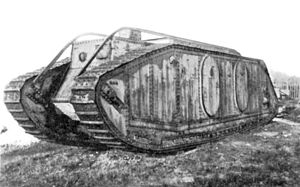Mark IX tank
| Mark IX | |
|---|---|
 | |
| Specifications | |
| Mass | 27 t |
| Length | 9.7 m (31 ft 11 in) |
| Width | 2.5 m (8 ft 1 in) |
| Height | 2.64 m (8 ft 8 in) |
| Crew | 4: commander, driver, mechanic, machine gunner; up to 30 men could be carried. |
| Armor | 10 mm |
Main armament | 2 x .303 MG's |
Secondary armament | none, but loopholes for 16 soldiers |
| Engine | Ricardo 6-cyl petrol 150 hp (112 kW) |
| Power/weight | 5.6 hp/tonne |
| Suspension | unsprung |
Operational range | ? |
| Maximum speed | 6.9 km/h (4.3 mph) |
The Mark IX tank was a British armoured fighting vehicle from the First World War, the world's first specialised Armoured Personnel Carrier.
Development
During the first actions with tanks it became clear that often infantry couldn't keep up with the tanks; not because soldiers were too slow - the early tanks themselves could only move at a walking pace - but because of enemy machine gun fire, the reason that tanks were invented in the first place. Often positions gained at very great cost would immediately be lost again for lack of infantry to consolidate. At first it was thought this problem could be solved by cramming a few infantry soldiers into each tank. It soon transpired however that the atmosphere quality in the tanks was so poor that infantry, if not losing consciousness outright, would at least be incapacitated for about an hour after leaving the tank, merely to recover from the noxious fumes.
Therefore, in the summer of 1917 , Lieutenant G.R. Rackham was ordered to design an armoured vehicle specifically for troop transport. At first the design was complicated by the demand that the vehicle should also be capable of being fitted with sponsons, so that it could be turned into a more modern tank in case the Mark VIII design proved to be a failure. This is why the type was designated as a tank, the Mark IX. However, this requirement was soon dropped and in September 1917 construction began by Armstrong, Whitworth & Co. in Newcastle-upon-Tyne of two prototypes of the pure transport vehicle (which could also serve as a supply tank). The prototypes were approved in the following year and 200 vehicles were ordered to be built by the tractor manufacturer Marshall, Sons & Co. of Gainsborough, Lincolnshire. At the time it had become clear that even the stretched Mark V* wasn't really suited for infantry transport.
Only three vehicles were finished at the time of the Armistice and only 34 were to be built in total.
Description
As there was no time for a completely new design, the Mark IX was based on the Mark V, with the hull lengthened to 9.73 m. The 150 hp Ricardo engine was moved to the front, the gearbox to the back and the suspension girders left out entirely. This created an inner space 4 metres long and 2.45 m wide, enough room for thirty (officially even fifty!) soldiers or ten tons of cargo. To ensure sufficient stiffness for the chassis, the floor was reinforced by heavy transverse girders. The infantry inside had to contend with the control rods for the gears running along the roof and the drive shaft through the middle. No seats were provided for them.
The crew proper consisted of a driver, a commander sitting to the right of him (the first time for a British tank, showing adaptation to the traffic conditions in France), a mechanic and a machine gunner who could man a gun in a hatch at the back. A second machine gun was fitted in the front. Along each side of the hull were eight loopholes, through which the soldiers could fire their rifles, making the Mark IX also the world's first Infantry Fighting Vehicle. Two of the loopholes were in the two oval side doors on each side.
Despite using thinner (10 mm) armour plate, the weight was still 27 tons and the speed only 4 mph (7 km/h). The tank could also carry supplies in a tray on the roof behind the commander's armoured observation turret (being the highest point at 2.64 metres), while towing up to three loaded sledges.
Rackham tried to improve internal conditions by putting a large silencer on the roof together with ventilation fans; there was no separate engine room however. Because of this lack of compartimentalisation it is questionable whether the project reached its original goal of designing a vehicle capable of delivering a squad of infantry in fighting condition.
Operational History and Project
The Mark IX's were used for some years after the war. The type was named The Pig as the low front of the track looked like the snout of one. One of the first three was used as an armoured ambulance. One other was rebuilt as an amphibious tank by the staff of the test base at Dollis Hill. It already had large bulk; this was improved by fitting drums at the front and sides. Long wooden boards were attached to the track links but at one side of the board only; as they reached the curve of the track they would project out propelling the tank through the water. Pictures were made of a floating tank in Hendon Reservoir at 11 November 1918, the very day of the Armistice. There is an oral tradition that this vehicle was named The Duck, but there is a strong suspicion as to its veracity.
The last Mark IX survives at the Bovington Tank Museum.
